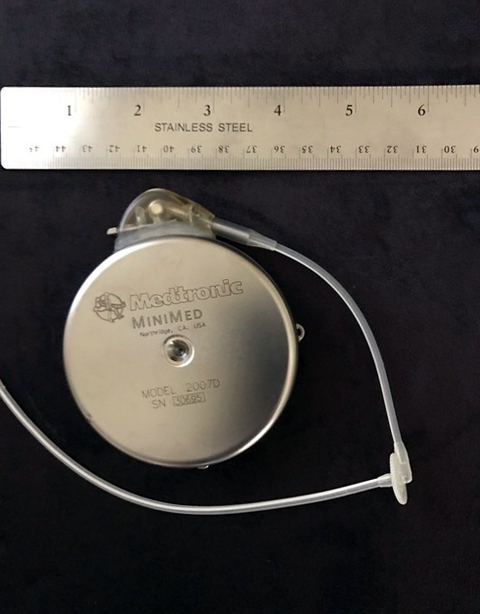WHAT IS THE IMPLANTABLE INSULIN PUMP?
How is it Different From The Pumps You Know?
How is it Different From The Pumps You Know?
The implantable insulin pump is not the insulin pump that you are probably familiar with and may be currently using. Presently, there are fewer than ten people in the United States who have an implantable insulin pump and so it is virtually unknown here. In fact, there are fewer than 500 people in the entire world who have an implantable insulin pump.
The external insulin pump: Most of us are familiar with what we all call an Insulin Pump and there are two basic types of these devices. The oldest and most common type is a small device – often worn clipped to a belt or some part of the clothing. These devices deliver insulin through a long, thin catheter (flexible tube) that penetrates the skin to deliver insulin subcutaneously. More recently, Patch Pumps have become available. The main difference is that the patch pump does not have a long catheter – the entire pump sits directly on the skin and delivers insulin through a short catheter that is covered by the body of the patch pump – again the insulin is delivered subcutaneously. Both types of these external insulin pumps may be programmed to deliver a variety of basal rates and will deliver a bolus upon demand.
The insulin that is delivered subcutaneously by these devices, enters the general blood circulation and is distributed throughout the body. As a result, the liver receives a dilute concentration of insulin and the rest of the body receives too much insulin. This is opposite to the normal pattern of insulin delivery in a nondiabetic person. This is a profound difference.
The implantable insulin pump: The implantable insulin pump is surgically implanted under the skin and a catheter from the pump extends into the peritoneal cavity*. The critical difference is that the insulin delivered to the peritoneal cavity is quickly routed to the liver – the normal destination for insulin. With the implantable insulin pump the liver receives a high concentration of insulin, keeps a large percentage of it and allows only a small amount to pass to the rest of the body. This more closely (than subcutaneous insulin delivery) matches the way insulin is delivered in people who do not have diabetes.
There are fewer than 500 of us in the world today who have an implantable insulin pump and all of us have the same pump and none of us will give it up – even though there are elements of the pump that we all agree are in serious need of development and improvement. These much needed improvements were simply not possible with the technology available in the 1990s. The remarkable thing about this is that with current technological capabilities it is now possible to create a far superior implantable insulin pump that would address most if not all of the improvements needed. Check out the videos on this website to see what actual implantable insulin pump users have to say.
The era of implantable insulin pump therapy in diabetic patients began in 1980 when the first experimental insulin pump was implanted in a diabetic patient at the University of Minnesota in Minneapolis. Within the following twelve months experimental insulin pumps had been implanted by three additional centers. These centers were located in Albuquerque, New Mexico; Vienna, Austria and Montpellier, France. Three uniquely different pumps were implanted (two of the four centers implanted the same version of a pump). Check out the tab “The History of the Development of the Implantable Insulin Pump” to view more detail of the history of the development of the implantable insulin pump.
Today’s implantable insulin pump: The implantable insulin pump that we now have (the only one that currently exists) was developed in the United States by a small, innovative company based in California called MiniMed. MiniMed was founded by the visionary entrepreneur, Al Mann. MiniMed also developed and marketed what became the world’s leading external insulin pump while concurrently developing early models of its implantable insulin pump. As with most innovations, early models of the implantable insulin pump were far from perfect and fortunately, MiniMed continued to invest in developing and improving the device. By the year 2000 MiniMed had produced a very promising, version of their implantable insulin pump and was in the process of incorporating a continuous glucose sensor and control algorithm into the device to create an artificial pancreas.
In 2001, MiniMed was purchased by Medtronic and in 2007 Medtronic announced the worldwide termination of the implantable insulin pump (at the time there were approximately 100 patients in the U.S. and hundreds more in several European countries where the pump had gained the European CE mark of approval). There was international dissatisfaction following this termination decision and ultimately Medtronic elected to continue support for the pump in Europe – but not in the United States. Patients in the U.S. were told that their pumps would no longer be maintained and were urged to have their pumps explanted.
Only limited modifications have been made to the pump since 2001.
*The peritoneum is the area surrounding internal organs such as the liver, spleen, pancreas, etc.

The implantable insulin pump and the patient controller. The controller is used to wirelessly communicate with the pump to set basal patterns and to deliver boluses.

THE CURRENT IMPLANTABLE INSULIN PUMP:
Diameter = 8 cm (3.15 inches)
Thickness = 2 cm (0.79 inches)
Weight empty = 131 grams
Insulin Volume = 13 – 15 ml.